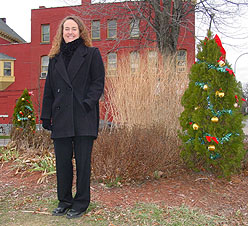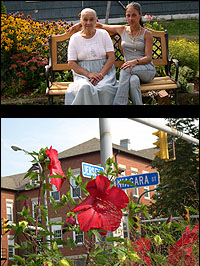Archives
Documenting the life history of a vacant lot
By DONNA BUDNIEWSKI
Reporter Assistant Editor
On the corner of Niagara and Jersey streets in Buffalo is a community garden, with bright red hibiscus blooming in spring and summer, and evergreens decorated for the holiday season. The once-vacant lot is testament to how communities throughout Buffalo are reclaiming blighted, abandoned property and turning it into welcoming green space and a source of fresh food. The Niagara/Jersey Community Garden, for example, is sponsored by the Niagara/Jersey Block Club.

IGERT Fellow LaDona Knigge stands in
a community garden at Niagara and Jersey streets in Buffalo, one of 54
gardens she's idenfitied in the city.
PHOTO: DONNA BUDNIEWSKI
The gardens also may be a way in which members of urban neighborhoods can reclaim political visibility and empowerment, says LaDona Knigge, a graduate student in the Department of Geography and a fellow with the IGERT (Integrative Graduate Education Research and Traineeship) program at UB.
Knigge's research, born of her interest in how public space is used and a love of gardening, as well as how geographic information systems (GIS) represent such space, focuses on the processes through which community members and organizations negotiate the use of space that a community garden affords and how that negotiation impacts their community and themselves on a personal level.

Two summer-time views of the
Niagara/Jersey Community Garden
PHOTOS: LADONA KNIGGE
She also is interested in the social implications of GIS and improving its ability to give more than just a quantitative description of an urban landscape—because, she explains, the maps generated by such processes are used to make policy and political decisions, in spite of the fact that maps don't often tell the whole story of a particular neighborhood or community. Knigge says the data obtained by mapping neighborhoods through GIS can represent changes taking place in those areas that have constructed community gardens and track stories associated with those changes.
In all, Knigge has identified about 54 gardens in Buffalo, which, she says, most likely doesn't represent all of the community gardens in the city. Of these, about 25 are ornamental (for beautification), about 17 are both ornamental and food-bearing, and seven are specifically for growing food. The food gardens are sponsored primarily by organizations such as the Buffalo Community Market, Loaves & Fishes soup kitchen and The Food Bank of Western New York. Ten of the gardens are associated with schools and located on school property or cared for by a school as the sponsoring organization. The remaining five lots either do not have a garden yet, are in the middle of bed preparation or did not have a garden last year, says Knigge, who spent last summer photographing all of the gardens she discovered and soon will interview residents living near or working the gardens to find out as much as possible about history of the former vacant lots to see how they've changed over time and to determine how the presence of the gardens have impacted community members.
Knigge points out that she's chiefly interested in the strategies residents use to work the gardens and whether this collective involvement leads to further political action within communities. She asserts that welfare devolution and increased focus on personal responsibility has prompted members of marginalized or poor neighborhoods to band together through the creation of community gardens, becoming politically visible in the process.
"There is an ideology that says that all people have equal access to housing and employment options, and promotes flexible housing and employment programs for low income people, with little or no consideration of the structural barriers that prevent members of marginalized groups from accessing equal housing and employment opportunities, the importance of family networks and the survival strategies necessary to cope with every day life," says Knigge. "Residents are held responsible and accountable for the decisions that they make about where to live-in poor neighborhoods-and the jobs that they take-often dead-end, low-paying jobs," she contends. "We don't take into account that the reason someone is living in a particular neighborhood is because a family member in that neighborhood can provide daycare for their children."
Consequently, the constraints related to access to personal transportation and the loss of access to personal or family networks that moving to the suburbs for better housing or employment options would entail, says Knigge, make community gardens a viable way for people who "choose" to stay in their neighborhoods to supplement their food supply, beautify their neighborhood and create community space by claiming access to vacant space, thus keeping it free from rubbish, rodents and crime, and creating a political base or identity through their involvement in community gardens. "This is what they do to make their lives work and make them better," she says. "What I like about the gardens," says Knigge, is that it's a way for community members to become involved in bottom-up political action."
Some of those dedicated to reclaiming vacant lots wage a daily war against garbage and graffiti, painting over it every day if need be, reports Knigge, and finding support, however small, from passersby who stop and take notice, if only to say, "this looks really nice."
Organizations or community members wishing to create a community garden must petition the City of Buffalo because the process of taking over a vacant lot requires a contingent, three-year lease agreement with the city and liability insurance, which is one way groups can begin to receive recognition as a political entity, says Knigge. "It gives them a sense of credibility," she notes. "Because the city can't afford to maintain vacant lots, neighborhoods are left with the responsibility to clean them up," she adds.
Within a one-block area of a Connecticut Street neighborhood, three different community groups have reclaimed three vacant lots, cleaning them up, planting flowers, installing picnic tables and improving them aesthetically with the installation of a bit of artwork in the form of stars laid as stones, with the names of the children who worked in the vacant lot engraved on them to create a garden path. The groups managing the three lots are as diverse as a motorcycle club and the Buffalo Niagara Realtors Association.
Her research has forced her to travel throughout Buffalo's neighborhoods—including areas that have a bad reputation, says Knigge, and she's been surprised to find that the reputation of a neighborhood doesn't always match up with reality. "I was very impressed with the gardens in the Fruitbelt neighborhood-some are just so beautiful. People are really proud of them," she says.
What has most impressed Knigge are the people she's met during her research, whether they're in their neighborhoods working in the vacant lots or city activists committed to making community gardens work by providing such support as plants, training and insurance.
